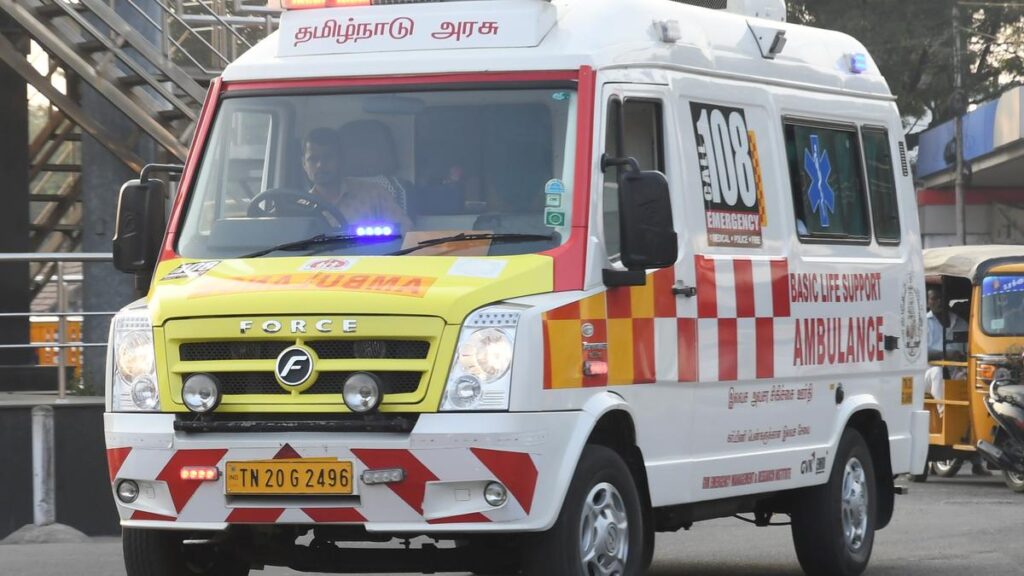
Nationally, the average ambulance response time ranges from 25 to 30 minutes. File photograph used for representational purposes only
| Photo Credit: The Hindu
The difference between life and death during a medical emergency often hinges on a single factor: time. In cities such as Bengaluru, Mumbai and Delhi, traffic congestion routinely swallows precious minutes, undermining even the best medical interventions.
Urban traffic delays are a critical, often overlooked cause of preventable mortality. Multiple studies and audits confirm that delays in ambulance response times are directly linked to increased trauma fatalities and deteriorating patient outcomes. For example: in Delhi, the average ambulance response time has risen to over 17 minutes, up from 13 minutes in 2014, despite an increase in fleet size. A 2021 Comptroller and Auditor General report on Karnataka found that nearly 90,000 crash victims did not receive timely care due to ambulance unavailability and delays, and in 6,000 cases, dispatch itself was delayed by over 30 minutes.
Nationally, the average ambulance response time ranges from 25 to 30 minutes, with rural areas faring even worse. According to the National Crime Records Bureau, a significant proportion of accident deaths in Indian cities occur in transit, before patients reach a hospital.
The ‘Golden Hour’ – the first 60 minutes after trauma or acute medical events is critical for survival, particularly in cases of stroke, cardiac arrest, or severe injuries. Yet, in India’s congested metros, this window is often lost to traffic

Technology as a medical intervention
To address these systemic delays, hospitals and civic authorities are increasingly turning to technology to optimise emergency medical logistics.
One example of this is GPS-based ambulance tracking: real-time GPS integration allows for dynamic route optimisation, live tracking, and early hospital alerts. In cities where such systems are implemented, response times have improved. In Chennai and Kolkata, GPS-enabled fleets have reduced response times by 12–15%. Door-to-CT times for stroke patients have also improved, enabling quicker thrombolysis and better outcomes.
Another intervention is traffic signal pre-emption: pilot projects have demonstrated that traffic signal override systems—where ambulances automatically trigger green lights—can reduce journey times. However, only a few urban intersections in India are currently equipped for such digital interventions.
Bike ambulances: in gridlocked or narrow urban zones, two-wheeled ambulances staffed by trained paramedics have proven invaluable. Under Karnataka’s ‘Platinum Ten Minutes’ initiative, bike ambulances were first responders in one-third of trauma cases in Bengaluru, with a median arrival time of under six minutes—less than half that of traditional van ambulances. Early stabilisation in such cases has been lifesaving.

The roadblocks we still face
Despite technological advances, several barriers persist.
One of these is inadequate infrastructure: fewer than one in five urban traffic signals can support override systems; most still rely on manual or timer-based controls. This apart, there are technology gaps as well: GPS signal loss, uncharged devices, and software glitches can cause further lapses.
Another barrier is public apathy. Surveys indicate that 62% of ambulance drivers report motorists refusing to yield, and 45% have to personally request drivers to make way at least once a week. Laws on “ambulance right of way” need to be enforced more stringently.

Integrating urban health and urban mobility
Improving emergency care outcomes in India’s cities will require coordinated action. This includes: mandating GPS tracking and digital dispatch for all emergency vehicles under Central health schemes; integrating traffic signal pre-emption technology into the Smart Cities Mission; launching public awareness campaigns and enforcing legal consequences for failing to yield to ambulances and establishing decentralised trauma stabilisation units at high-traffic nodes.
Time is the most critical element in emergency treatment. When the Golden Hour is lost to traffic, it is not merely a delay – it is often a preventable death.
As clinicians, we must advocate for systemic change, because when every second matters, the fight is not just against disease or injury, but against the clock and the traffic of the city itself. Only by integrating technology, infrastructure and civic responsibility can we truly reclaim the Golden Hour for our patients.
(Dr. V. Viju Wilben is a consultant, Emergency Department, Narayana Health, Bengaluru. [email protected])
Published – June 13, 2025 08:30 am IST

